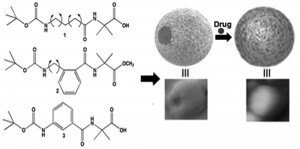Posted on behalf of Gwenda Kyd, web writer for CrystEngComm
Many important drug molecules are hydrophobic so methods to successfully introduce these into the body and make them bioavailable must be developed. Peptide-based molecules are an attractive delivery vehicle due to their biocompatibility, recognition properties, biodegradability and hydrophobic-hydrophilic balance.
A new paper shows how three gamma-peptides, with different degrees of flexibility, can self-assemble to form porous microspheres (see diagram below). The anticonvulsant drug carbamazepine has been encapsulated in these microspheres, which range in diameter from 300nm-1µm. The microspheres have limited water solubility, so there is a sustained release of the drug by dissolution of the microsphere. The authors suggest tailoring of the capsule properties could lead to controlled drug delivery and release.
Find out more in the paper:
Fabrication of microspheres from self-assembled γ-peptides
Suman Kumar Maity, Santu Bera, Arpita Paikar, Apurba Pramanik and Debasish Haldar
CrystEngComm, 2013, Advance Article
DOI: 10.1039/C3CE40689J, Paper












